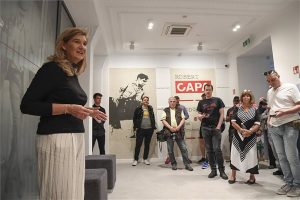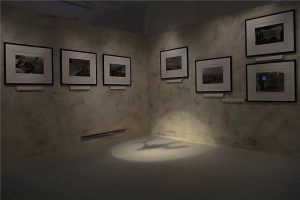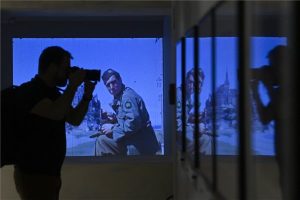Influencer Dorka Demeter aims to show the international public the beauty of Hungarian Art Nouveau in the Carpathian Basin.Continue reading

The Correspondent, the first permanent exhibition dedicated to the work of the world-famous photographer, Robert Capa (born Endre Friedmann), opened on Tuesday at the Robert Capa Contemporary Photography Center in Budapest.
The Capa Center was established in 2013, in part to showcase the Robert Capa Collection, which was purchased by the Hungarian state in 2008, Orsolya Kőrösi, the director of the institution recalled at the exhibition’s press launch on Tuesday.
Kőrösi underlined that only three of the series selected by the renowned photographer’s brother, Cornell Capa. and his monographer Richard Whelan, covering Robert Capa’s entire career, were produced, making Budapest the most important custodian of the Capa legacy, alongside New York and Tokyo.

Orsolya Kőrösi at the opening of the permanent Robert Capa exhibition, The Correspondant, on Tuesday. Photo:MTI/Kovács Tamás
The creation of the space displaying the Master Collection of 937 copies began in 2017, with the government contributing a total of HUF 813 million (EUR 2,19 million) in 2017 and 2021 for the renovation and construction of the exhibition, she said.
The Capa exhibition is housed in the Art Nouveau cinema room (formerly the Tinódi Cinema and later the Budapest Chamber Theater), which was built in 1912, and will be vastly renovated.
Visitors are able to see 137 Robert Capa photographs (which will be replaced from time to time for art conservation reasons) and a further 400 projected images.
Gabriella Csizek, curator of the two-story exhibition, said that
the image spaces are complemented by information spaces that present the photographer’s life, his personality and contemporary photography through interactive surfaces, film recordings, radio interviews, projected images, and documents.
Capa’s photographs are presented in chronological order, according to the themes defined by his oeuvre.
He was born in Budapest in 1913 to a Jewish family. During his 20s he emigrated to Paris and visited several parts of Europe and the world. During his career as a photojournalist, Capa reported from five battlefields, including the Spanish Civil War, World War II, and the First Indochina War, where he died after stepping on a landmine, at the age of 40.

Photo: MTI/Kovács Tamás
This itinerary is not only a walk through time and space, but also a kind of inner journey that traces the artistic and personal fulfillment of Capa, who set out from Budapest in the early 1920s and then traveled and worked on almost every continent, before tragically coming to an abrupt end.
Visitors can discover iconic Capa images from the Spanish Civil War (including the world-famous Death of a Militia Man), the Sino-Japanese War, and the theaters of war in the Second World War, such as the Normandy landings.
Capa’s camera reveals life in the newly liberated territories, in post-war Budapest, in a nascent Israel, and in the Soviet Union as the Iron Curtain was about to fall. Alongside the images of destruction and reconstruction, the ‘sunny side’ also emerges, as Capa captured many of the figures of contemporary art life; but the final shots take us back to the war, to battle-torn Indochina, where Capa sacrificed his life to produce his last photographic report.

Photo:MTI/Kovács Tamás
The exhibition, covering some 500 square meters, also commemorates the 110th anniversary of Capa’s birth.
Via MTI, Featured Image via MTI/Kovács Tamás